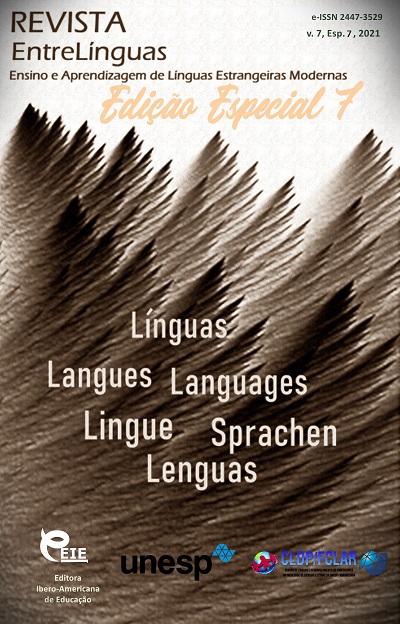The plant life in the onomastic worldview of the tatars
DOI:
https://doi.org/10.29051/el.v7iesp.7.16331Keywords:
The Tatar Language, Onomastics, Linguoculturology, Ethnoculture, PhytonymyAbstract
The onomastic worldview reflects the most important aspects of culture and history, world outlook and psychology of the people. The meaning of some onomastic units contains hidden informational layers of archaic mythological thinking. One of the most significant groups among those units includes names of the plant world. This article is aimed at demonstrating the specificity of the plant life representation in the onomastic worldview of the Tatars. The analysis involves interpretation of the meaning of toponyms and anthroponyms retaining repercussions of beliefs of the ancient Turks. The analysis was carried out on linguistic and culturological material by means of a complex of interdisciplinary methods and techniques. The conducted analysis revealed that the tradition of using names of flora as proper nouns traces its origin to the archaic forms of mythology, which conceived a tree as the supreme god’s symbol. The ancient naïve views of the Turks were transmitted to the modern onomastics of the Tatars. Due to its stability, the toponymic system retains the earliest views. In the anthroponymic system, despite the fact that many of ancient anthroponyms grew out of use, traditions and motives of naming continued when borrowing anthroponyms from other languages
Downloads
References
(1969). Ancient Turkic Dictionary. Leningrad, 676 p.
(1993). “Dialect Dictionary of the Tatar Language” (in Tatar), 789 p.
BLAGOVA, G. Anthroponymic System as Projection of Cosmological and Social Views of the Ancient Turks. Comparative-historical Grammar Book of the Turkic Languages. The Ancient Turkic Proto-Language. The Worldview of the Ancient Turkic Ethnos by the Language Data”, Moscow, 660–754. 2006.
GALIULLINA, G., YUSUPOVA, A., KHADIEVA, G., & DENMUKHAMETOVA, E. Turko-Tatar Vocabulary as Cognitive Mapping of the National Mentality. Kazan, 120 p. 2001.
ISAEV, Y. Phytonymic Conceptuary as Dictionary of a New Type (a case study of the Chuvash and Tatar Languages. Cheboksary, 191 p. 2013.
ISMAGILOVA, A., GALIULLINA, G., & KUZMINA, KH. Functional potential of mother tongue in conditions of bilingualism among youth of the Republic of Tatarstan. Modern Journal of Language Teaching Methods, 66–70. 2016.
Kamilovna Khadieva, G., Raisovna Galiullina, G., Khatipovna Kuzmina, K., & Airatovna ABDRAKHMANOVA, A. Metaphoric Terms in Tatar Toponyms as the Reflection of the National World-View. Research in Applied Linguistics, 10(Proceedings of the 6th International Conference on Applied Linguistics Issues (ALI 2019) July 19-20, 2019, Saint Petersburg, Russia), 802-808. 2019.
Khatipovna Kuzmina, K., Kamilovna Khadieva, G., Raisovna Galiullina, G., & Ramilevna AKHUNZHYANOVA, D. The History of the Development of Literary Tatar Language in the 20th Century (Based on the Example of the Language of Literary Works). Research in Applied Linguistics, 10(Proceedings of the 6th International Conference on Applied Linguistics Issues (ALI 2019) July 19-20, 2019, Saint Petersburg, Russia), 847-854. 2019.
KHVOLSEN, D. News on the Khazars, the Burtas, the Bulgars, the Magyars, the Slavs, and the Rus by Abu-Ali Ben-Omar Ibn-Dast. Saint-Petersburg. 1869.
KOVALEVSKIY, A. Book by Akhmed Ibn Fadlan on his Journey to the Volga in 921-922. Khar’kov, 345 p. 1956.
MUKHAMETOVA, I. I., KADIROVA, E. K., YUSUPOV, A. F., & ALKAYA, E. SOMATISMS IN THE OLD TATAR LANGUAGE. Revista TURISMO: Estudos e Práticas, 1, 1-5. 2019.
SATTAROV, G. Anthroponyms of the Tatar Autonomous Soviet Socialist Republic. (in Tatar), Kazan, 296 p. 1973.
SUPERANSKAYA, A., STALTMANE, V., PODOLSKAYA, N., & SULTANOV, A. Theory and Methods of Onomastic Research. Moscow, 254 p. 2007.
YERBULATOVA, I., KIRILLOVA, Z., & SAHIN, L. National and Cultural Realias of Translations into Tatar. Humanities and Social Sciences Reviews, 7(6), 984–987. 2019.
YUSUPOVA, A. S., GALIULLINA, G. R., & DENMUKHAMETOVA, E. N. Representation of national mentality in Turkic-Tatar vocabulary. Life Sci J, 11(7), 506-508. 2014.
Downloads
Published
How to Cite
Issue
Section
License

This work is licensed under a Creative Commons Attribution-NonCommercial-ShareAlike 4.0 International License.
Os manuscritos aceitos e publicados são de propriedade da Revista EntreLínguas. Os artigos publicados e as referências citadas na Revista EntreLínguas são de inteira responsabilidade de seus autores.
Transferência de direitos autorais – autorização para publicação
Caso o artigo submetido seja aprovado para publicação, já fica acordado que o(s) autor(es) autoriza(m) a UNESP a reproduzi-lo e publicá-lo na EntreLínguas, entendendo-se os termos “reprodução” e “publicação” conforme definição respectivamente dos incisos VI e I do artigo 5° da Lei 9610/98. O artigo poderá ser acessado pela rede mundial de computadores (Internet), sendo permitidas, a título gratuito, a consulta e a reprodução de exemplar do artigo para uso próprio de quem a consulta, desde que haja a citação ao texto consultado. Essa autorização de publicação 328 EntreLínguas, Araraquara, v. 1, n .2, p. 323-328, jul./dez. 2015 não tem limitação de tempo, ficando a UNESP responsável pela manutenção da identificação do(s) autor(es) do artigo. Os artigos publicados e as referências citadas na Revista EntreLínguas são de inteira responsabilidade de seus autores.











